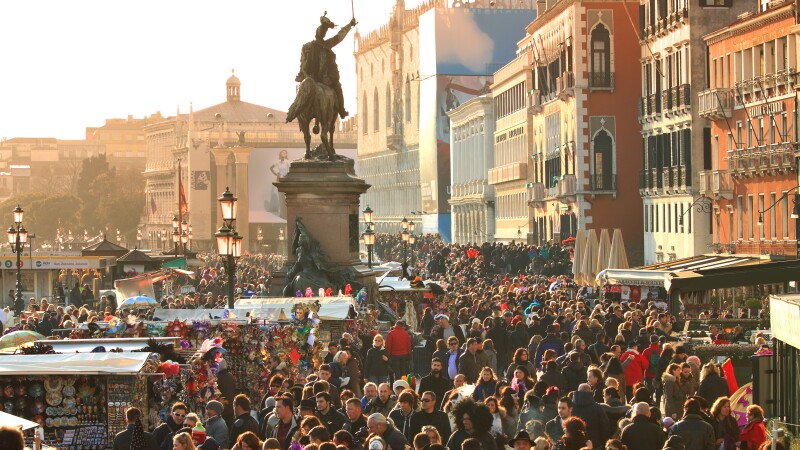Travelers often complain about crowds and are always looking for a way to avoid them. But the people who live in very popular places know that those crowds don’t ever go away. While residents may enjoy a real economic benefit from visitors, unchecked tourism has also caused overcrowding, put a strain on local resources, and in some cases, decreased a region’s livability.
Last summer’s anti-tourism protests in Venice, Barcelona, and other European cities marked a breaking point for residents of those communities: The negative impacts of overtourism were outweighing the benefits of their tourism dollars. Around the world, popular destinations have started taking steps to address the issue. Peru began limiting the amount of time visitors can spend in the ruins of Machu Picchu, and some U.S. national parks are considering requiring time-specific reservations.

Tourists pack into the historic center of Venice near Piazza San Marco.
Photo by Rostislav Glinsky/Shutterstock
Several tour outfitters are joining the fight, too, adjusting their itineraries to minimize impact on popular places, while still offering access to the destination’s most appealing characteristics.
Off-season and off-the-beaten-path trips
Intrepid Travel now focuses on running trips to Europe between October and March, which is considered the off-season. It has also launched trips to less-visited places, including Finland, Poland, Belarus, Moldova, and Cyprus, as well as off-the-tourist-trail areas like southern Morocco instead of Marrakech, or northern Peru instead of Machu Picchu.
The highlight of my recent Intrepid Travel Morocco Atlas and Atlantic trip was visiting the town of Tafraoute in the Anti-Atlas Mountains. The heart of the Berber homeland is far from the bustling souks and resorts of Morocco, and while most tourists head north of Marrakech, we’d gone south. I wandered among uncrowded babouche and jewelry shops, talked with women in argan oil co-operatives, and got to know residents over coffee in local cafés—all while being one of only a handful of visitors in town.
Another focus for tour companies is bringing travelers beyond the typical tourist destinations to places where they can immerse themselves in local culture. Exodus Travels encourages travelers headed to Peru to embark on the Moonstone Trek, rather than the popular Inca Trail. Moonstone hikers share the path with Peruvians instead of other tourists. In Croatia, Exodus Travels puts another local spin on a popular destination with its Dalmatian Coast cycling trip: While travelers may end their route in Dubrovnik, they spend the majority of their days in small villages.
Smaller groups
Travel in small groups is another way tour operators address overcrowding. With fewer people, they can tread lightly, leaving less of a mark on the destination, especially in places where the infrastructure can’t handle lots of visitors.
“With fewer people, [small groups] can tread lightly, leaving less of a mark on the destination.”
National Geographic Expeditions has designed many of its active expeditions to take small groups of travelers to areas where not many tourists go. Its Iceland: Volcanoes, Glaciers, and Whales Adventure goes way beyond the overcrowded Golden Circle to the far eastern and northern parts of the island; its Alaska Sea Kayaking Adventure gives guests the opportunity to explore Glacier Bay by kayak—an intimate approach that avoids the crowds and the carbon footprint of big cruise ships.
Local guides and experiences
The appeal of notable destinations doesn’t just go away, and even though savvy travelers are willing to choose alternative adventures, popular cities still draw plenty of visitors. How do tour operators address the thirst for those top 10 places?
“The tsunami of people pouring through the city on a cruising day adventure changes the dynamic [of a place], and dipping your toe in for a couple of hours without much help to the economy of that place only highlights the negative impact,” says Leigh Barnes, North America regional director for Intrepid Travel. “We consider the balance of going to those destinations that are popular, but we also make sure that tourist dollars get to the local economy.”

You just can’t get this close to an iceberg on the deck of a cruise ship.
Photo by Sergey Yechikov/Shutterstock
Many tour operators employ local guides—they’re resources on the ground who have a deep understanding of the culture and a familiarity with the area that clues them into the best times to visit places on a tour itinerary. With the help of Youssef Laamimi, a trip leader for Intrepid Travel’s Urban Adventures, I not only learned to navigate the intimidating souks of Marrakech, but also visited the avenues few visitors investigate: those inhabited by the makers of the goods sold in the souks. There, I tried my hand at weaving leather pieces into sandals and learned to appreciate a craft that is often unseen by those haggling for the best bargain in the market.
In trying to be part of the overtourism solution, rather than part of the problem, outfitters are actually enabling their guests to experience all the parts of a culture rather than bungeeing in to grab and go—which is really what experiential travelers have wanted all along. >>Next: 5 Tips for Responsibly Exploring Reefs








